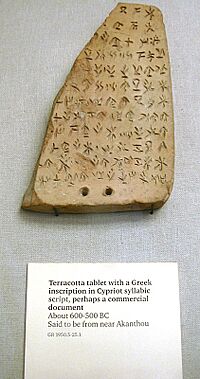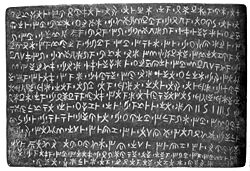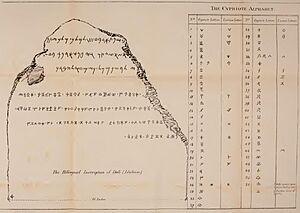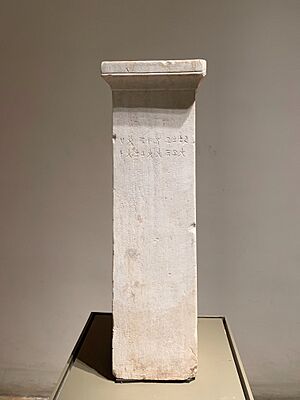Cypriot syllabary facts for kids
Quick facts for kids Cypriot |
|
|---|---|
 |
|
| Type | Syllabary |
| Spoken languages | Arcadocypriot Greek, Eteocypriot |
| Time period | 11th–4th centuries BCE |
| Parent systems |
Linear A
|
| Unicode range | U+10800–U+1083F |
| ISO 15924 | Cprt |
| Note: This page may contain IPA phonetic symbols in Unicode. | |

The Cypriot syllabary is an ancient writing system. It was used on the island of Cyprus a very long time ago, from about 1100 BCE to 300 BCE. This was during the Iron Age. It was a way to write down the Greek spoken in Cyprus, especially a dialect called Arcadocypriot Greek. It was also used for another language called Eteocypriot. Eventually, the Greek alphabet replaced the Cypriot syllabary. King Evagoras of Salamis helped make this change happen.
Contents
Where Did It Come From?
The Cypriot syllabary is believed to have come from an even older writing system called the Cypro-Minoan syllabary. This older system itself likely came from Linear A, which was used on the island of Crete. These scripts are all part of a group of ancient writing systems from the Aegean Sea region. A big change from Linear A to Cypriot syllabary was that many picture-like symbols (ideograms) disappeared. The earliest examples of this writing are found on clay tablets. Over time, the signs became simpler, just patterns of lines. This change happened naturally as people used the script more and more.
How the Syllabary Works
The structure of the Cypriot syllabary is very similar to that of Linear B. This is because they both came from similar origins and were used for early forms of Greek. The Cypriot script contains 56 different signs. Each sign usually stands for a whole syllable, which is a sound unit like "ka," "ke," "ki," "ko," or "ku." This is why it's called a syllabic writing system. Each sign represents an "open" syllable, meaning a consonant followed by a vowel (like "CV"). It doesn't use signs for syllables that end with a consonant (like "CVC").
| -a | -e | -i | -o | -u | |
|---|---|---|---|---|---|
| 𐠀 | 𐠁 | 𐠂 | 𐠃 | 𐠄 | |
| w- | 𐠲 | 𐠳 | 𐠴 | 𐠵 | |
| z- | 𐠼 | 𐠿 | |||
| j- | 𐠅 | 𐠈 | |||
| k-, g-, kh- | 𐠊 | 𐠋 | 𐠌 | 𐠍 | 𐠎 |
| l- | 𐠏 | 𐠐 | 𐠑 | 𐠒 | 𐠓 |
| m- | 𐠔 | 𐠕 | 𐠖 | 𐠗 | 𐠘 |
| n- | 𐠙 | 𐠚 | 𐠛 | 𐠜 | 𐠝 |
| ks- | 𐠷 | 𐠸 | |||
| p-, b-, ph- | 𐠞 | 𐠟 | 𐠠 | 𐠡 | 𐠢 |
| r- | 𐠣 | 𐠤 | 𐠥 | 𐠦 | 𐠧 |
| s- | 𐠨 | 𐠩 | 𐠪 | 𐠫 | 𐠬 |
| t-, d-, th- | 𐠭 | 𐠮 | 𐠯 | 𐠰 | 𐠱 |
To see these special symbols, you might need a compatible font installed on your computer. Your web browser also needs to support Unicode characters in the U+10800–U+1083F range.
Cypriot vs. Linear B: What's Different?
Even though they are similar, the Cypriot syllabary and Linear B have some key differences in how they use their symbols. In Cypriot, if a word ends with a consonant, an extra, silent "e" sound is added. For example, final consonants like "n," "s," and "r" are written using "ne," "se," and "re." Groups of consonants are also written by adding extra vowels. Sounds like "ae" or "eu" (called diphthongs, which are two vowel sounds together) are spelled out completely. However, if a nasal sound (like "n" or "m") comes before another consonant, it's often left out.
For example, the Greek word for "human" (ánthrōpos) was written differently in each script. In Linear B, it might look like 𐀀𐀵𐀫𐀦 (a-to-ro-qo). In Cypriot, it was 𐠀𐠰𐠦𐠡𐠩 (a-to-ro-po-se), which was read from right to left.
Another small difference is how they show certain sounds. In Linear B, sounds like "l" and "r" are covered by one set of symbols. But "d" and "t" sounds have separate symbols. In the Cypriot syllabary, "d" and "t" are combined, while "l" and "r" have their own distinct symbols.
Different Styles of Writing
The way the signs look can be slightly different depending on where they were found. Experts divide the Cypriot syllabary into two main types based on location: the "Common" type and the "Paphian" type. The Paphian style was used in the southwestern part of Cyprus, around the city of Paphos.
Uncovering Ancient Writings

The Cypriot syllabary was a mystery for a long time. But in the 1800s, a smart person named George Smith figured out how to read it! He used a special stone called the Idalion bilingual. This stone had the same text written in two different languages: Greek (using the Cypriot syllabary) and Phoenician (a different ancient language). By comparing the two texts, Smith and other scholars like Samuel Birch were able to crack the code.
What We've Found
About 1,000 examples of writing in the Cypriot syllabary have been found across Cyprus. These writings are different in length and how well they are preserved. Most of them are from around the 6th century BCE. We haven't found any writings from before the 8th century BCE. Many of the discovered tablets are from graves and usually just have the names of the people who died. Some writings were also found that were dedicated to gods, but these didn't help much with understanding the script. The most important tablets were found in places like Enkomi and Paphos.
People started collecting and publishing these writings in the 1800s. Later, in the 1900s, T. B. Mitford and Olivier Masson continued this work. In 2015, Massimo Perna put together a complete and corrected collection of 1,397 inscriptions.
Discoveries at Enkomi
The oldest writing found in Cyprus was discovered in Enkomi in 1955. It was a piece of a thick clay tablet with only three lines of writing. Experts immediately noticed it looked similar to other ancient scripts. Because this fragment was dated to about 1500 BCE, which was much older than Linear B, language experts realized that the Cypriot syllabary came from Linear A, not Linear B. Other clay tablet pieces were also found in Enkomi. These were from a later time, around the late 13th or 12th century BCE. The writing on these later tablets had changed quite a bit, with the signs becoming simpler lines. Experts called this newer script the Cypro-Minoan syllabary.
The Idalion Tablet: A Key Discovery
Idalium was an ancient city in Cyprus, located where the modern town of Dali is today. This city became important because of its copper trade thousands of years ago. From this area, archaeologists found many examples of the later Cypriot syllabic writings. In fact, Idalium gave us the most important clue for deciphering the Cypriot syllabary: the Tablet of Idalium. This is a large bronze tablet with long writings on both sides. The Tablet of Idalium is from about 480–470 BCE.
The text on the tablet is mostly complete and well understood. It describes an agreement between King Stasicyprus and the city of Idalium with a doctor named Onasilus and his brothers. The king promised them certain pieces of land as payment. This was for the doctors' help in caring for wounded soldiers during a time when the city was under attack. This agreement was placed under the protection of the goddess Athena.
New Finds and What They Tell Us
New discoveries of Cypriot syllabary writings keep happening! Some recent finds include a small vase from the early 5th century BCE. It has two lists of Greek names written on it. Another find is a broken marble piece written in the Paphian style. This fragment seems to describe part of an oath. It often mentions King Nicocles, who was the last king of Paphos. It also includes some important words and phrases. Four more inscribed objects were found in the British Museum's storage: a silver cup, a jug, and two pieces of limestone tablets.
While many new inscriptions are found, most of them are short or only have a few signs. One example is a small clay ball with writing on it.
Cypriot Syllabary in the Digital Age
The Cypriot syllabary has been added to the Unicode Standard. Unicode is a system that allows computers to show text from all the world's writing systems. The Cypriot syllabary was included in April 2003 with version 4.0 of Unicode.
The special code range for Cypriot symbols in Unicode is U+10800–U+1083F. There's also a related Unicode block for Aegean Numbers, which is U+10100–U+1013F.
| Cypriot Syllabary | ||||||||||||||||
| 0 | 1 | 2 | 3 | 4 | 5 | 6 | 7 | 8 | 9 | A | B | C | D | E | F | |
| U+1080x | 𐠀 | 𐠁 | 𐠂 | 𐠃 | 𐠄 | 𐠅 | 𐠈 | 𐠊 | 𐠋 | 𐠌 | 𐠍 | 𐠎 | 𐠏 | |||
| U+1081x | 𐠐 | 𐠑 | 𐠒 | 𐠓 | 𐠔 | 𐠕 | 𐠖 | 𐠗 | 𐠘 | 𐠙 | 𐠚 | 𐠛 | 𐠜 | 𐠝 | 𐠞 | 𐠟 |
| U+1082x | 𐠠 | 𐠡 | 𐠢 | 𐠣 | 𐠤 | 𐠥 | 𐠦 | 𐠧 | 𐠨 | 𐠩 | 𐠪 | 𐠫 | 𐠬 | 𐠭 | 𐠮 | 𐠯 |
| U+1083x | 𐠰 | 𐠱 | 𐠲 | 𐠳 | 𐠴 | 𐠵 | 𐠷 | 𐠸 | 𐠼 | 𐠿 | ||||||
| Notes | ||||||||||||||||
| Aegean Numbers | ||||||||||||||||
| 0 | 1 | 2 | 3 | 4 | 5 | 6 | 7 | 8 | 9 | A | B | C | D | E | F | |
| U+1010x | 𐄀 | 𐄁 | 𐄂 | 𐄇 | 𐄈 | 𐄉 | 𐄊 | 𐄋 | 𐄌 | 𐄍 | 𐄎 | 𐄏 | ||||
| U+1011x | 𐄐 | 𐄑 | 𐄒 | 𐄓 | 𐄔 | 𐄕 | 𐄖 | 𐄗 | 𐄘 | 𐄙 | 𐄚 | 𐄛 | 𐄜 | 𐄝 | 𐄞 | 𐄟 |
| U+1012x | 𐄠 | 𐄡 | 𐄢 | 𐄣 | 𐄤 | 𐄥 | 𐄦 | 𐄧 | 𐄨 | 𐄩 | 𐄪 | 𐄫 | 𐄬 | 𐄭 | 𐄮 | 𐄯 |
| U+1013x | 𐄰 | 𐄱 | 𐄲 | 𐄳 | 𐄷 | 𐄸 | 𐄹 | 𐄺 | 𐄻 | 𐄼 | 𐄽 | 𐄾 | 𐄿 | |||
| Notes | ||||||||||||||||
See also
- Pre-Greek substrate
- Tamassos bilinguals


